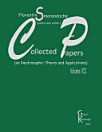Improvement to the Gradient Projection Method Used to Find the Optimal Solution for Neutrosophic Nonlinear Models Constrained by Equality Constraints
Maissam Jdid · Florentin Smarandache
Infinite Study
Ebook
17
Pages
family_home
Eligible
info
reportRatings and reviews aren’t verified Learn More
About this ebook
A mathematical model consists of decision variables, a goal function, and constraints. The region of possible solutions for a nonlinear mathematical model is the set of vectors whose components satisfy all constraints. The optimal solution is the vector whose components satisfy all constraints, and at which the function reaches an optimal value (maximum or minimum). Nonlinear programming constitutes an important and fundamental part of operations research and is more comprehensive than linear programming. Its applications have spread across all branches of science, including engineering, physics, chemistry, management, economics, and military fields, among others. Nonlinear programming can also be used in forecasting, estimation, applied statistics, and determining the costs resulting from the production, purchase, and storage of goods. Given this importance, and in order to obtain a more accurate solution that takes into account all the changes that the system under study may be exposed to, we have previously presented a neutrosophic study of nonlinear models and some of the methods used to find the optimal solution. In addition to what we have previously done, in a research we present an improvement to the gradient projection method used to find the optimal solution for nonlinear models constrained by equal constraints, enabling us to obtain the optimal solution in fewer steps. We will then apply it to find the solution. Optimization of nonlinear neutrosophic models.
Rate this ebook
Tell us what you think.
Reading information
Smartphones and tablets
Install the Google Play Books app for Android and iPad/iPhone. It syncs automatically with your account and allows you to read online or offline wherever you are.
Laptops and computers
You can listen to audiobooks purchased on Google Play using your computer's web browser.
eReaders and other devices
To read on e-ink devices like Kobo eReaders, you'll need to download a file and transfer it to your device. Follow the detailed Help Center instructions to transfer the files to supported eReaders.







